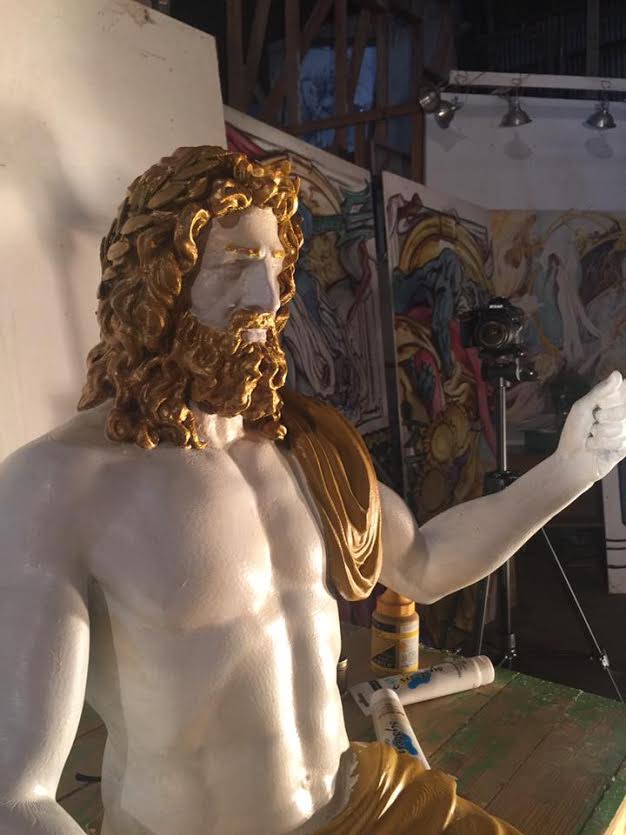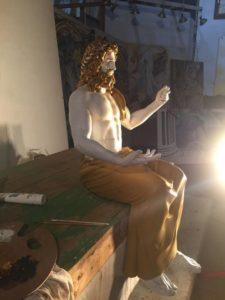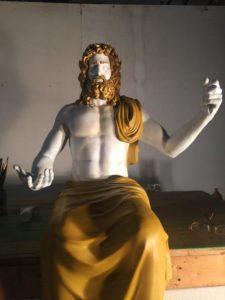The ancient world was a strange and wonderful place — and chief among the wonders of the time were a series of specially noted Wonders of the World. These seven Wonders included the Great Pyramid of Giza in Egypt, the Hanging Gardens of Babylon (whose actual existence is still debated), the Temple of Artemis at Ephesus, the Mausoleum at Halicarnassus, the Colossus of Rhodes, the Lighthouse of Alexandria, and the Statue of Zeus at Olympia. It’s this final Wonder that holds our particular interest today, as it is going to be on display for the first time in over a millennium and a half.
Originally conceived by the sculptor Phidias in 422 BCE, the Statue of Zeus in Olympia was a true wonder, ultimately standing — after 12 years of construction — at an enormous 43 feet tall, the famed statue created palpable awe in all who beheld it. Modeled from a description of Zeus in The Iliad, Homer’s epic work inspired Phidias’ creation of the god crowned with an olive wreath, seated upon a throne rich in ebony, ivory, precious stones, and gold; Zeus’ sandals and robe were golden, with carvings of flora and fauna dotting his robe, and he held in one hand a small statue of the winged goddess of victory, Nike, and in the other hand a scepter topped with an eagle. Roman generals were moved to awed silence, men of the world forgot their troubles just for seeing the splendor — and by the fifth century CE, it was gone forever, preserved only in likenesses on coins and in the stories of those who had seen it. Destroyed in a fire, likely in Constantinople, with the exact circumstances long since lost to time, it’s been well over a millennium since anyone has seen the legendary Statue of Zeus. Indeed, six of the seven ancient Wonders have been destroyed by fire, time, and vandalism — but thanks to 3D technologies, this no longer means all must be lost forever. As we’ve seen, 3D printing has tremendous abilities in reviving works of art thought to be lost to time. While some have been cataloged to save from the destruction of terrorists as a preemptive (or preservative) measure, others have to be reconstructed using more creativity than simply scanning the originals. And this is where a fantastic collaborative effort between some big names in both antiquities and high-tech developments comes into play.
 Recently, industry leader Stratasys teamed up with the Millennium Gate Museum of Atlanta as well as Kennesaw State University to bring the new — a Fortus 900mc Production 3D Printer — and the old — a long-lost Wonder of the World — together for a thrilling exhibition, unveiled just as the 2016 Summer Olympics kick off in Rio de Janeiro.
Recently, industry leader Stratasys teamed up with the Millennium Gate Museum of Atlanta as well as Kennesaw State University to bring the new — a Fortus 900mc Production 3D Printer — and the old — a long-lost Wonder of the World — together for a thrilling exhibition, unveiled just as the 2016 Summer Olympics kick off in Rio de Janeiro.
Thanks to Fused Deposition Modeling (FDM) technology, the Statue of Zeus is ready to be back in the world, brought to life as a new, stunning 6-foot-tall statue created with the accuracy and speed that Stratasys’ Fortus line of 3D printers are known for.
“Throughout history, there are always instances where the most precious works of art get destroyed or broken. In the past, this disappearance meant items were lost forever. That’s why we’re so heavily invested in the artistic value of 3D printing. Committed to working at the intersection of technology and art, we see the tremendous potential of 3D printing for educational applications. Alongside Stratasys and the educators at Kennesaw State University, our hope is to deliver creations far too few have even tried to attempt,” said Jeremy Kobus, Director of The Gate Museum.
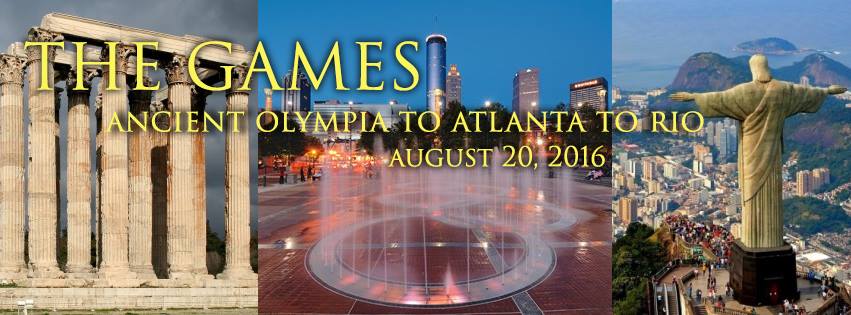 The 3D printed Statue of Zeus of Olympia is set to be a centerpiece at the Millennium Museum, with August 20th marking the opening of an exhibit called “The Games: Ancient Olympia to Atlanta to Rio“. While the original statue was long since destroyed, the ancients carefully documented its intricate design. Using an initial image of this design, today’s design team was able to turn it into a detailed rendering and CAD file using ZBrush, before 3D printing the full statue. With Atlanta having hosted the Centennial Olympic Games 20 years ago, it seems a fitting time to unveil this commemorative statue in the city now.
The 3D printed Statue of Zeus of Olympia is set to be a centerpiece at the Millennium Museum, with August 20th marking the opening of an exhibit called “The Games: Ancient Olympia to Atlanta to Rio“. While the original statue was long since destroyed, the ancients carefully documented its intricate design. Using an initial image of this design, today’s design team was able to turn it into a detailed rendering and CAD file using ZBrush, before 3D printing the full statue. With Atlanta having hosted the Centennial Olympic Games 20 years ago, it seems a fitting time to unveil this commemorative statue in the city now.
“Artists around the world are being liberated by the full-fledged realism made possible by Stratasys 3D printing technology. Having the capacity to design and 3D print using highly durable materials with complex geometries and the highest levels of accuracy, museums can re-introduce some of history’s most treasured works. Teaming with Stratasys, institutions are completely transforming education and learning – as students and museum visitors are now able to grasp the power of forgotten classic art. 3D printing is the very impetus sparking a highly realistic learning experience – ensuring these essential pieces of history are never again forgotten,” said Sig Behrens, General Manager of Global Education, Stratasys.
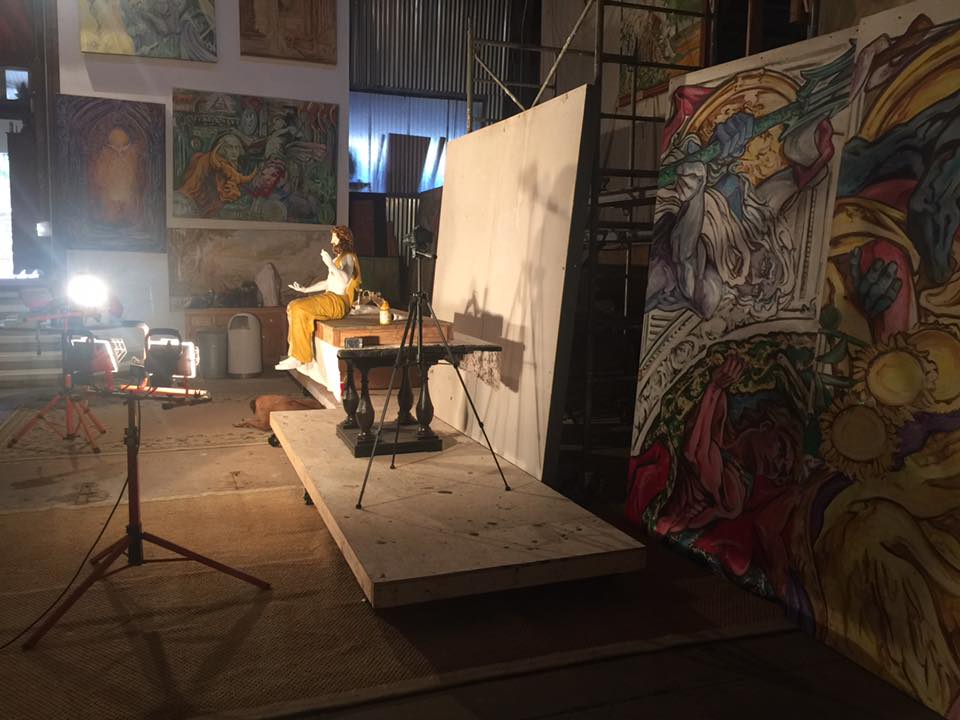
The 3D printed Zeus sitting in Stan Mullins Art Studio during finishing [Photo: Stan Mullins Art Studio Facebook]
- 3D Digital Design: 3DPtree
- 3D Printing & Slicing: Stratasys
- 3D Printing & Education: Kennesaw State University 3D
- Finishing & Throne Creation: Stan Mullins
- Education: Technical Training Aids
Stratasys has put together a fantastic video showcasing the creation of the statue, and I was thrilled to learn more about it directly from the team involved, as well.
https://youtu.be/GzvoMGtd05A
With the statue set to highlight The Games exhibit at the Millennium Museum, alongside Greek artifacts from California’s Hearst Castle Collection and Georgia’s Michael C. Carlos Museum, the exhibit will present artifacts, both ancient and re-engineered, of Olympic and Greek history going back millennia. Some of the team members involved in this project were also kind enough to add more detail, as I had A Few Questions For those involved, eager to learn more.
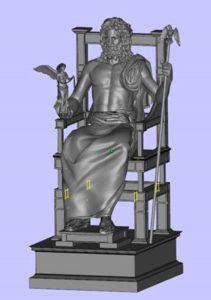 Below is a Q&A with the team, offering a better look behind the scenes at this Olympic undertaking.
Below is a Q&A with the team, offering a better look behind the scenes at this Olympic undertaking.
How did Stratasys come to work with the Millennium Gate Museum and Kennesaw State University?
“Kennesaw State University is a great partner for us who has many Stratasys printers installed across their campus. From there, a local partner in Georgia approached us with the opportunity,” explained Jesse Roitenberg, National Education Manager at Stratasys.
What makes FDM technology the right choice to recreate an ancient Wonder?
How does the Fortus 900mc Production 3D Printer serve the best function for this project? What materials were used?“The reliability of Stratasys 3D Printers, the strength of the ASA material chosen, and the properties are perfect for this project. We used a material that is UV resistant and is a real thermoplastic, so it is extremely durable,” continued Roitenberg.
“The size of the statue warranted use of the 900mc and the speed of the 900mc was needed as the time of project completion was tight,” Mac Cameron, Applications Engineer at Stratasys, told us.
How long did the 3D design process take? What about the actual printing? The post-processing? Who all was involved on the team for this project?
What will happen to this statue after the Olympics/after this exhibition?“The part was designed in Z Brush, which was about 2 months to get all the final designs complete. From those files – it was a week to fix, scale, and section them to be 3D printable. Afterwards, the models of Zeus, Nike, and the Eagle took a little less than 4 days to produce. Zeus was printed in Eden Prairie, MN at Stratasys and the Nike and Eagle were printed in Kennesaw, GA at Kennesaw State University. This was followed by light post-processing. It’s a fantastic example of elite manufacturing collaboration. Utilizing 3D printers and software in different locations, we were able to complete an accurate representation of the ancient Zeus statue in just over a month,” Roitenberg explained (with emphasis).
“The statue will be widely featured as a permanent piece of the museum’s collection,” Rodney Mims Cook, Jr., President and Chairman of the National Monuments Foundation, tells us.
Are there plans to recreate any other ancient World Wonders?
“Yes,” Cook continued, “we’re going to recreate the Historic Mims Park Peace Column, which was approximately 100 feet tall and topped by a 16-foot statue of the Co-Founder of Georgia. It will be the largest classical monument to Native Americans in the United States.”
It’s certainly astounding to see what 3D technologies can do. With one of the Seven Wonders of the Ancient World already 3D printed, and a national monument next up to be recreated, it seems that we’ve certainly found an incredible use of 3D printing. While some may question whether we should be reviving lost works, there certainly are those who believe that this is absolutely a worthwhile, and fully artistic, endeavor. Whether these 3D printed recreations will themselves stand the test of time remains a question, but in the meantime, those of us living in this age where ancient Wonders can be brought into today’s museums certainly do benefit from the intersection of new and old. What are your thoughts on this project? Discuss further in the 3D Printed Ancient Wonder forum over at 3DPB.com.
- [Photo provided to 3DPrint.com by Stratasys]
- [Photo provided to 3DPrint.com by Stratasys]
Subscribe to Our Email Newsletter
Stay up-to-date on all the latest news from the 3D printing industry and receive information and offers from third party vendors.
Print Services
Upload your 3D Models and get them printed quickly and efficiently.
You May Also Like
Reinventing Reindustrialization: Why NAVWAR Project Manager Spencer Koroly Invented a Made-in-America 3D Printer
It has become virtually impossible to regularly follow additive manufacturing (AM) industry news and not stumble across the term “defense industrial base” (DIB), a concept encompassing all the many diverse...
Inside The Barnes Global Advisors’ Vision for a Stronger AM Ecosystem
As additive manufacturing (AM) continues to revolutionize the industrial landscape, Pittsburgh-based consultancy The Barnes Global Advisors (TBGA) is helping shape what that future looks like. As the largest independent AM...
Ruggedized: How USMC Innovation Officer Matt Pine Navigates 3D Printing in the Military
Disclaimer: Matt Pine’s views are not the views of the Department of Defense nor the U.S. Marine Corps Throughout this decade thus far, the military’s adoption of additive manufacturing (AM)...
U.S. Congress Calls Out 3D Printing in Proposal for Commercial Reserve Manufacturing Network
Last week, the U.S. House of Representatives’ Appropriations Committee moved the FY 2026 defense bill forward to the House floor. Included in the legislation is a $131 million proposal for...



